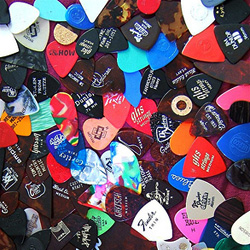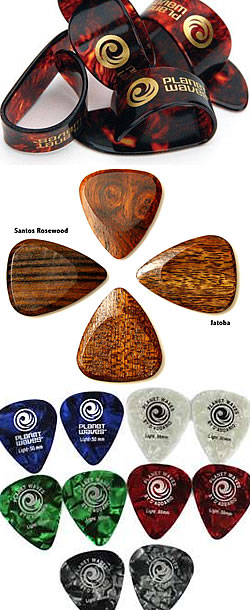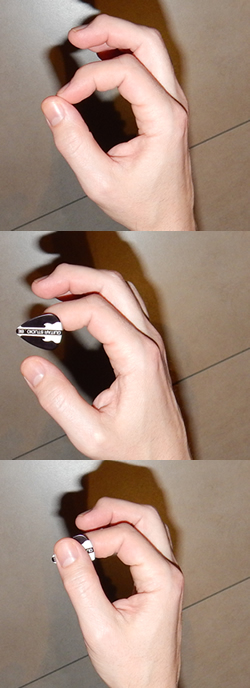Tips for better guitar pick technique
On an electric guitar you often play with a guitar pick (picking or flatpicking). Other techniques are hybrid picking (guitar pick combined with fingers) or finger picking (only with the fingers or nails). Some famous guitarists who play an electric guitar without a pick include Mark Knopfler (Dire Straits) and Jeff Beck. Some guitarists play with a thumbpick and their fingertips, or with fingerpicks, a kind of picks that you put on your fingertips.
It is important to master a good picking technique to achieve a great sound, dynamic, expression and speed. What is a good guitar picking technique and what are essentials to look out for in order to teach yourself a good picking technique?

Which guitar picks should you choose?
Plectrums come in many types, colors, shapes, sizes and materials. The color and drawing are not important, but the shape, size, thickness and material of the pick are very important. Which pick a guitarist ultimately prefers is rather personal and sometimes depends of the music style. While playing, only the tip of the pick may touch the strings, and your skin should not touch the strings. As far as the shape is concerned, it is important to create as little friction as possible with the string, with a pointed shape being ideal. This minimizes the contact between string and pick, but it does give you a slightly sharper sound. That’s why as many guitarists prefer a stomper versus a pointed end. A sharper end does wear off faster, and this is also the reason why top guitarists use multiple picks during a performance: the tip has become blunt! A sharper end wears off faster, and this is also the reason why top guitarists use multiple picks during a performance: the tip has become blunt! Depending on the material, you can tighten the tip back with a knife. As for the thickness of the pick, it is best to choose a pick with a thickness of 0.7 up to 2 millimeters. With thinner picks, there is less control while playing the guitar. With thicker picks, the guitarist has way more control! Playing well with a thicker pick requires more of your guitar picking technique, but is essential if you want to learn to play tightly, dynamically and expressively.

Material and thickness of the guitar picks
There are picks made of a lot of materials, but most commonly used is of course plastic, especially nylon and celluloid. But there are many more good materials to make picks such as carbonate, stone, metal, bone, and even certain types of wood and titanium. The better plastic picks, if they start to wear off, can be sharpened with a knife. Sharpening metal picks is just a little bit more difficult.
Personally, I avoid picks made of metal (such as brass). These picks are just too loud, sound very shrill and you also have to pay attention … the elements (pickups) of your guitar are actually magnets. So you should definitely not get too close with a metal pick. Picks made of soft material wear out faster and give a darker tone. The touch of the pick on the string sounds higher, brighter, sharper if the pick is made of harder material. What you like better is a matter of taste and of course also depends on the music style! Styles like funk and hardfunk (like Red Hot Chili Peppers or Nile Rodgers by Chic) can’t be played with a thin or too soft pick.
Rather thin picks can only be used for rhythm guitar (chords). And mainly used by beginners who do not yet master much pick technique and / or have little control over their right hand. You absolutely cannot play solos properly with thin picks because they have not enough control and bend too much. The medium picks are most commonly used (around 0.75 mm thickness), they bend a little, but not too much. In terms of sound, they sit between thin and thick picks. The heavy and extra heavy picks don’t bend at all. Therefore you must have a good guitar pick technique and a good control over your right hand. If not, you would quickly lose the pick while playing.
Holding guitar pick
A lot of guitarists hold the pick incorrectly. But still, there are no standard rules on how to hold a guitar pick. If we should believe the standard rules of many websites, we have to conclude that top guitarists such as John Petrucci and Steve Morse often hold their pick incorrectly. Though, I think those guys are quite good guitarists, aren’t they :-)? But OK, some guidelines when you are just starting to play the guitar are important and necessary. For example, if you hold the pick between your fingertips, it will always tend to move and rotate. Where the attack will always happen at a different angle, plus you have the risk of dropping the pick.

So what is one of the better ways to hold a pick?
Make a zero shape with your thumb and indexfinger. Place the pick on the side of your index finger and now put your thumb on top of it. It is important that you keep that zero shape in order to be able to move flexibly with your fingers to obtain more dynamics and expression.
Way of hitting the string (attack)
Because we are mainly talking about guitar pick technique here, we are not going to expand too much on the attack. Mainly, there are 4 ways of attack techniques with a pick: supporting with the fingers, supporting with the wrist or the side of the wrist, stroking loose from the wrist and striking from the arm. Of course, this is too much to include in this chapter. But briefly …
In order to play fast and tight, it is important that stroking the string is a constant and light motion, a movement in which the guitarist is in control of what is happening. Pick technique has a downward stroke (downstroke) and an upward stroke (upstroke), which must be a constant movement that happens exactly the same every time. According to the shape of your hand and fingers, your pick is never completely parallel to your strings, which is why an upstroke always has just a little more accent than a downstroke.
In many music styles such as pop, rock, grunge, metal, where the riffs have to sound very mechanical and tight, only downstrokes should be used. With other styles or techniques, the slightly harder upstrokes give the desired effect such as jazz, swing, reggae, ska, etc. When playing fast (speed picking), it is best to turn the pick slightly until it is parallel to your string. The distance between pick and string must then be the same for both the upstroke and downstroke, so that the accents disappear and more speed can be made.
But also this is very personal. Guitarists such as Paul Gilbert continue to keep their pick tilted during speed picking, because it adds a slightly scraping effect to the sound of the picking. In any case, limit the friction of the pick with the string as much as possible in order to gain more speed. It is important that the strings are only struck with the tip of the pick, again to limit friction. Less friction is less waste of energy.

